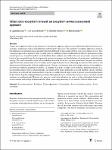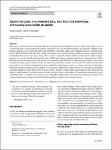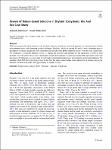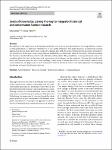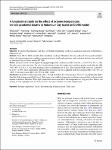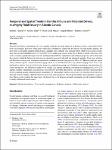Search
Author
- Osman, Ahmed I. (5)
- Chen, Zhonghao (2)
- Ricohermoso III, Emmanuel (2)
- Wang, Yongbin (2)
- next >
Subject
- LCA (6)
- ICP-MS (3)
- Artificial intelligence (2)
- CDW (2)
- next >
Date issued
Search Results
Using a novel approach based on the urban ecosystem services approach, this research explores the relation between socio-economic, architectonic and ecological factors in urban renewal processes. This deductive conceptual approach is based on the definition of an urban diagnosis and intervention model based on the concept of urban socio-ecosystemic services. This conceptual approach is applied to three research cases in Andalusia (Spain) neighbourhoods linked to participatory urban renewal processes. A model is inductively defined from these analysed case studies: the socio-ecosystemic services model, based on the conceptual frame, the development of particular instruments and the definition of a participatory methodological strategy. |
Current evidence that supports the correlation between training and energy efficiency in the construction industry is sparse and lacks an in-depth and sector-wide analysis. Several context-specific (in terms of application, workforce segment, and scope) studies have highlighted several barriers, challenges, and gaps in the training landscape in the European construction sector. However, these do not scale up and translate to robust evidence for the entire industry. The paper aims to address this gap by adopting a quantitative and qualitative Europe-wide consultation that not only seeks to gather evidence about the relationship between training and energy efficiency but also broadens the scope of the investigation beyond this aim to understand the complexity of the training landscape... |
This article considers how the construction practices of marginalized communities in Rio de Janeiro link the provision of essential housing to distant forest environments and markets for wood building materials. As elsewhere in Brazil, many families without access to real estate markets have built their own homes using locally available materials, a right protected by the 1988 Constitution and federal law. Today, these houses are typically built from reinforced concrete and clay bricks and finished with a roof of clay tile or cheaper fiber-cement corrugate. Production and sale of fiber-cement, which contains asbestos, were restricted by Rio de Janeiro State law in 2001 and ruled unconstitutional by Brazil’s Supreme Court in 2017. But little attention has been given to the human and ... |
NbS have gained substantial attention in the academic literature recently as a potential approach for simultaneously tackling environmental issues and addressing societal challenges. Drylands, which are among the world’s most vulnerable areas to the impacts of climate change and cover a little less than the half of the global terrestrial surface, were the focus of this study. We conducted a systematic literature review to explore the potential opportunities for the application of NbS in rural drylands across the globe. We go on to specifically consider the possibility of applying selected NbS approaches in the Aral Sea region of Uzbekistan, as a case study of a dryland ecosystem illustrating major environmental and social challenges. We highlight which NbS show the most promise in t... |
China’s Belt and Road Initiative is now the world’s largest infrastructure initiative, with long-term climate change effects, and the Green Investment Principles (GIPs) for Belt and Road have been promoted as a key instrument to green the Belt and Road. This article focuses on the question: What role do the GIPs play in building a green Belt and Road and addressing relevant regulatory challenges? Based on the theory of nodal governance, it is argued that the GIPs’ two-layered networks facilitate China to influence investment decisions over many countries along the Belt and Road indirectly through fund providers as key nodes to transition toward green investment. China also avoided direct interference with the domestic policies of host countries through the GIP network. |
Recognition of the importance of protecting agrobiodiversity is not a new phenomenon. Crossing different sciences is often pinpointed as a relevant contributor to its successful protection. This paper proposes an integrated research approach in history and conservation science by opening new paths for using written historical sources in biodiversity inventories. It discusses some conceptual and methodological challenges raised by historical research regarding the diversity and distribution of wild and cultivated edible plants. The possibilities of using historical sources for compiling plant lists that can be integrated into biodiversity databases are also explored. |
The long-term sustainability of the African Great Lakes is strongly connected to the management and monitoring of their coastal areas. Yet, the communities that live in these areas are rarely involved in monitoring and have limited influence on key management issues. Furthermore, regulatory activities and knowledge sharing in these transnational ecosystems are strongly limited by funding and infrastructure limitations. Citizen science has great potential to advance both scientific and public understanding of the state of the environment. |
In this work, the potential adsorption abilities of mineral materials such as zeolite (Ze), halloysite (Ha), chalcedonite (Ch), and Devonian sand (DS) used as low-cost resources for the removal of Rhodamine B (RhB) from aqueous solutions were investigated in batch conditions. Adsorption kinetics and equilibrium and the effect of solution reaction (pH) were studied. Adsorption kinetic data were analyzed using two kinetic models: pseudo-first-order and pseudo-second-order models. Adsorption kinetics was better represented by the pseudo-second-order model. Equilibrium data were analyzed by the Freundlich, Langmuir, and Sips isotherms. |
To explore the frequency and effect of extreme temperature on the non-accidental death rate in Hulunbuir, a Chinese ice city. |
Infaunal invertebrate communities of coastal marine sediments are often impacted by human activities, particularly in harbours and estuaries. However, while many studies have attempted to identify the key factors affecting benthic infauna, few have done so for highly energetic tidal estuaries. Samples were collected over a decade (2011–2020) from a series of reference sites in Saint John Harbour (45.25° N, 66.05° W), a highly tidal estuary in the Bay of Fundy, Canada. These data were used to examine spatial and temporal trends in infaunal invertebrate communities and sediment properties and to determine the extent to which the biological patterns were driven by measured physical and chemical variables. |

